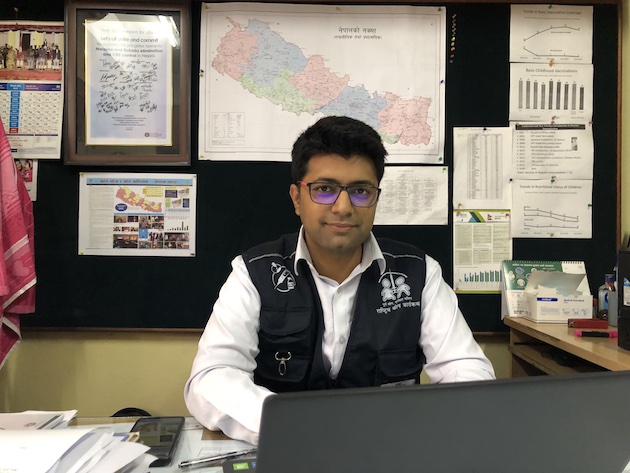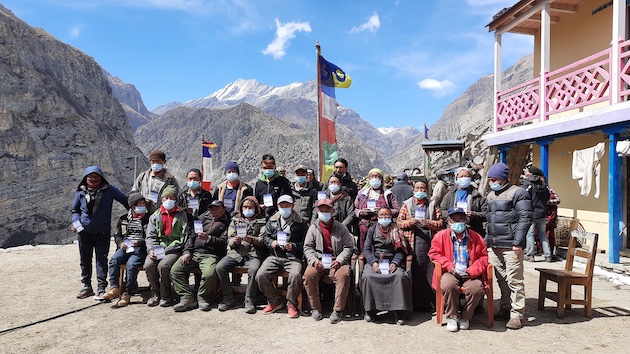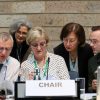Tuesday, May 21, 2024
News and Views from the Global South
Health
Nepal’s Covid-19 Immunization Campaign – An Unlikely Frontrunner

Healthcare worker of Manang Delivering vaccine through risky road after flood in 2021. CREDIT: Badri Acharya/IPS
- Badri Acharya is currently at the helm of the public health office in Pokhara, a prominent city within Nepal’s Himalayan region and a renowned tourist hotspot.
However, in the past, he worked in the field, leading and delivering essential public health provisions in the isolated and demanding terrain of the Manang district-some 198 km north from Pokhara during the tumultuous period of the Covid-19 pandemic and the extensive devastation triggered by climate-induced flash floods.
“I walked for two days with our medical team to reach the remote village, Naar, up to the mountain, and did Covid-19 vaccinations,” Acharya explained. He described the perilous journey, which navigated through active landslides and steep slopes, saying, “We walked that path with courage, relying on tree roots to avoid falling into deep crevasses.”
Manang is known for its beautiful Himalayan terrain and the livelihood of locals, which is primarily based on indigenous knowledge. During the Covid-19 pandemic, places like Manang, Mustang, and Humla, became locked and isolated, where access to basic necessities was already nearly out of reach for villages like Naar and Fu.

Dr Abhiyan Gautam at his office desk, according to him, even during the Covid-19 pandemic, regular vaccination was also going on. CREDIT: Tanka Dhakal/IPS
However, these places managed to provide jabs smoothly during the high influx of Covid cases, showcasing the dedication of healthcare workers. “It was because of micro planning and coordinated efforts from every stakeholder,” Acharya added. The World Health Organization (WHO) recognized it as “exemplary efforts in ensuring vaccine equity” and stated, “which helped protect communities that might otherwise have been overlooked.”
Unlikely Frontrunner
In 2021, the infection rate was going upward, and there was a limited vaccine supply; still, places like Manang and Mustang were able to carry out immunizations without disruption.
How?
Thanks to a well-coordinated implementation plan of vaccination from the federal to provincial to local levels. According to Dr Abhiyan Gautam, the head of the Child Health and Immunization Service Section at the Department of Health Services, it was an uphill battle to combat the pandemic situation, especially for a country like Nepal where resources are limited, and distribution is challenging due to difficult road connectivity.

Villagers of Meta village after getting the vaccine. CREDIT: Badri Acharya/IPS
“Vaccine supply is always a major issue in geographically challenging areas, and with Covid, there was added pressure to vaccinate all eligible individuals,” Gautam said. “Thanks to back-and-forth discussions on policy, continuous guidance from experts, and dedication from healthcare workers on the ground, we were able to overcome challenges.”
There were existing challenges, including the lack of a cold chain to safely store vaccines and vaccine carriers to reach villages in the mountain region. In the midst of the pandemic, mountain districts like Manang and Mustang faced flash floods in 2021 that swept away roads, bridges, and houses. Public health expert Gautam said, “At that time, it was difficult to transport vaccines. Health workers used ropes to transfer vaccines from one place to another.”
Acharya, who was the head of the Public Health Office in Manang for two years (from November 2020 to March 2022), recalls the distress he experienced and how he and his team navigated that pressured situation.
“Already difficult situation worsened due to the flash flood,” he recalls, “there was no electricity for a week, and solar power also didn’t work for an extended period. We sought help to bring ice packs from Pokhara to preserve the vaccine.”
Physical distancing and other COVID-related precautions were impossible during the flood, adding the risk of infection spread and other public health concerns.
“We didn’t halt the vaccination drive and pursued an equity-based approach to vaccine rollout,” Acharya explained, “The situation in Manang and Kathmandu (the capital city of Nepal) differed; treatment access was available in Kathmandu but not feasible in Manang, so we emphasized preventive measures, focusing on vaccination for all eligible individuals.”
Initially, there was no formal authority from the federal level, but the provincial authority provided enough vaccines to cover all eligible individuals. “Only a few thousand individuals were eligible for the vaccine, yet we provided jabs to all village residents,” Acharya recalls, “A later federal-level decision was made to ensure vaccine equity in remote areas, which greatly aided us.”
According to the 2020 census data, Manang is the least populated district in Nepal, with 5,658 people, while Mustang is the second least populated, with a population of 14,000. In the first week of August 2021, Manang became the first district to vaccinate all individuals aged 18 or above (4,198), followed by Mustang, which administered jabs to 9,300 eligible residents at that time.
As of July 2023, the Family Welfare Division of the Department of Health Service states, “The Government of Nepal vaccinated 83.9% with the first dose and 83.4% with the full/second dose for the total population.” Gautam said, “Nepal achieved the milestone of vaccinating 70% of the total population (30.03 million) with the full dose on July 20, 2022, thanks to the exemplary work carried out by the unexpected frontrunners, Manang and Mustang.”
Lessons for the Future

Badri Acharya (second from right in front row) with his team heading to Meta Village at NaarFu, Manang. CREDIT: Badri Acharya/IPS
Both Gautam and Acharya, who invested long hours heading vaccination efforts during the pandemic era, emphasize that the battle is not yet over, but they harbour less concern about the situation now and hold hope for the future.
“The health institution itself was destroyed by the flood in some villages. However, the health workers did not give up,” Acharya recalls. “We provided encouragement. Health workers take pride in being part of this endeavour and remain prepared to act whenever required.”
Detailed micro-planning and the dedication of healthcare workers to serve the public good are the factors that enabled success in hard-to-reach areas of the upper mountains.
“We are now better equipped to store vaccines, with ultra and supra cold chain facilities,” Gautam added. “We feel more prepared than ever to confront a pandemic-like situation in the future. The Covid-19 pandemic tested and enhanced our ability to combat widespread infections.”
Note: This story was supported by the Sabin Vaccine Institute and Internews.
IPS UN Bureau Report

 Print
Print



